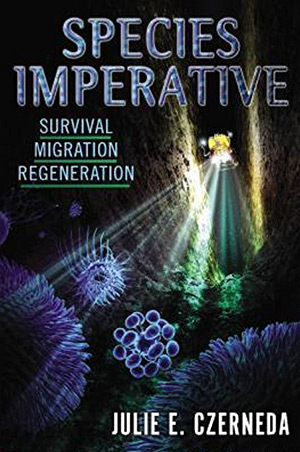Category: Fiction
Reviewed by: Marianne Dyson
NSS Amazon link for this book
Title: Survival
Author: Julie E. Czerneda
Format: Hardcover / Paperback
Pages: 401
Publisher: Daw Books
Date: 2004/2005
Retail Price: $23.95 / $7.99
ISBN: 0756401801 / 0756402611
Title: Migration
Author: Julie E. Czerneda
Format: Hardcover / Paperback
Pages: 464
Publisher: Daw Books
Date: 2005/2006
Retail Price: $24.95 / $7.50
ISBN: 0756402603 / 0756403464
Title: Regeneration
Author: Julie E. Czerneda
Format: Hardcover / Paperback
Pages: 543
Publisher: Daw Books
Date: 2006/2007
Retail Price: $24.95 / $7.99
ISBN: 0756403456 / 0756404118
Knowing that the sun will eventually expand and make Earth uninhabitable, migration into space is necessary for the survival of the human species. But how far will humans go in order to survive? Will we displace other species and destroy other world’s ecologies to make room for our biological priorities like we’ve done on Earth? Would we help a threatened species survive even if it put our own survival at risk?
Author Julie Czerneda addresses these ethical issues in her Species Imperative series that begins with Survival, continues with Migration, and ends with Regeneration. The main character, Dr. Mackenzie “Mac” Connor, is a salmon researcher working at a protected research station off the North American west coast. Her work on the role of species diversity has come to the attention of an alien archeologist named Brymn. A member of the mysterious Dhryn race, he is the first of his kind to visit Earth. He and his human diplomatic escort, Nik, show up at her field station and require her cooperation because it seems that the survival of Earth may be at stake.
Brymn is investigating a series of disappearances that appear connected to the destruction of worlds along a superluminal “highway” that is operated by an advanced and peaceful race called the Sinzi. The fear is that whatever destroyed a series of worlds in the past — totally stripping them of all life — is about to rise again. Soon after Mac is briefed on the situation, the research station is attacked by the Dhryn’s enemy, the “Ro,” and Mac’s friend and fellow researcher, Emily, is kidnapped.
Mac, who has never been interested in aliens or in traveling off-planet, ends up befriending Brymn, falling in love with Nik, trying to rescue her friend, and having her brain “rewired” to speak Dhryn — something no other human can do. Gradually, she uncovers the mystery of the Dhryn life cycle and its connection to the destruction of worlds while fighting her own desire to let someone else deal with it while she returns to Earth to study salmon.
From the perspective of having read all three books, I can say that a lot of the detail about the various aliens and their habits and habitats were not actually important to the plot. I had a hard time keeping all the races and individuals straight, and wish that I had not tried so hard to remember all of them! Then again, all those aliens and all their diversity is really what the story is about. Do we want a universe like that, complete with annoying pranksters and disgusting carrion eaters, or do we want to live in a universe whose sole purpose is to provide food and resources for one species — be that us or some other?
This question of “species imperative” is one that deserves serious consideration as humanity begins its migration into space. If we find other life out there, sentient or not, do we have a moral obligation to preserve it, even help it to survive — if that means that we must give up our own chance at survival? I believe we all want the answer to be that we can coexist, and that we will search for a way to do that, just like Mac searched for a way to preserve the Dhryn even though their existence appeared to threaten human survival.
Another issue in the story that should be of interest to people considering the human migration to space is the role of technology in “survival of the fittest.” Technology certainly determines which species survive on Earth — if we can’t eat or make a tool out of something, then we pour concrete over it. However, technology may give our species the ability to survive in a form that ends up limiting our future potential — and turns us into the kind of single-minded destructive species found in this book series. Instead of preserving our species, what may be more important is preserving the ability of our species to evolve and adapt itself to new environments. Perhaps we should accept that humans as humans will go extinct as surely as Earth will be swallowed by the sun — but work to prepare our bio-engineered, AI-enhanced offspring to inherit the stars.
Though some readers may find all the scientific details and alien-life speculations overdone, if kept in mind as examples of the rich tapestry that life has to offer, space enthusiasts should find the story entertaining and worthwhile discussing with friends.
© 2008 Marianne Dyson
Please use the NSS Amazon Link for all your book and other purchases. It helps NSS and does not cost you a cent! Bookmark this link for ALL your Amazon shopping!



















